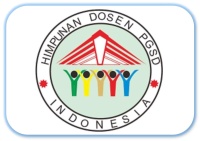Peningkatan Hasil Belajar Menggunakan Model Kooperatif Tipe Two Stay Two Stray di Sekolah Dasar
Abstract
This research is motivated by low student achievement. The aim of the study was to describe the increase in student learning outcomes in integrated thematic learning with the Two Stay Two Stray Cooperative Model in Class V SD Negeri 01 Bandar Buat. This type of research is classroom action research with a qualitative approach and a quantitative approach with four stages, namely planning, implementing, observing, and reflecting. Conducted in two cycles, cycle I consisted of 2 meetings, and Cycle II consisted of 1 meeting. The research subjects were teachers and fifth-grade students at SDN 01 Bandar Buat, totalling 27 people. The results showed that the observation of lesson plans for the cycle I averaged 83.32% (B) and increased in cycle II with a percentage of 94.44% (SB), in cycle I teacher activity an average of 86.10% (B) increased in cycle II with a percentage of 94.44% (SB), in the activity of students in cycle I an average of 86.10% (B) increased in cycle II with a percentage of 94.44% (SB) and student learning outcomes in cycle I averaged average 77.82 (C) increased in cycle II 91.72 (B). Thus, it can be concluded that the TSTS-type cooperative model can improve student learning outcomes in integrated thematic learning in class V SD Negeri 01 Bandar Buat Padang City.
Keywords
Full Text:
PDFReferences
Anita, Y., Putera, R. F., & Ladiva, H. B. (2020). Kognitif Moral dalam Upaya Pembangunan Emotional Intelligence Siswa Sekolah Dasar. Jurnal Mutiara
…, 5(2). http://e-journal.sari-mutiara.ac.id/index.php/JMT/article/view/1656
Azizah, A. (2021). Pentingnya Penelitian Tindakan Kelas Bagi Guru dalam Pembelajaran. Auladuna : Jurnal Prodi Pendidikan Guru Madrasah
Ibtidaiyah, 3(1), 15–22. https://doi.org/10.36835/au.v3i1.475
Bali, M. M. E. I. (2020). Penerapan Model Pembelajaran Two Stay Two Stray dalam Meningkatkan Keaktifan Belajar Pebelajar. Murobbi: Jurnal Ilmu
Pendidikan, 4(1), 29-42.
Eliyasni, R., Anita, Y., & Hanafi, A. S. (2020). Proses Pembelajaran Tematik Terpadu dengan Model Problem Based Learning (PBL) di Sekolah Dasar. Jurnal Mutiara Pendidikan Indonesia, 5(2), 1–8.
http://ejournal.unp.ac.id/students/index.php/pgsd/article/view/10322
Ermiana, I., Affandi, L. H., & Kusuma, A. S. H. M. (2019). Workshop Implementasi Penelitian Tindakan Kelas (PTK) Berbasis Lesson Study (LS) Di SD Negeri 15 Cakranegara. Journal of Chemical Information and
Modeling, 53(9).
Gustiansyah, K., Sholihah, N. M., & Sobri, W. (2021). Pentingnya Penyusunan RPP untuk Meningkatkan Keaktifan Siswa dalam Belajar Mengajar di Kelas. Idarotuna : Journal of Administrative Science, 1(2), 81–94.
https://doi.org/10.54471/idarotuna.v1i2.10
Handayani, N. (2018). Efektivitas Model Pembelajaran Two Stay Two Stray (Tsts) Ditinjau Dari Hasil Belajar Siswa Kelas V Sd Pada Mata Pelajaran Matematika. International Journal of Elementary Education, 2(1), 15–21.
https://doi.org/10.23887/ijee.v2i1.13904
Hidayah, N., Ahli, W., Bpsdm, M., & Penulis Korespondensi, A. (2020). Efektifitas Blended Learning Dalam Proses Pembelajaran. Jurnal Pencerahan, 14(1), 1693–7775. https://edukasi.kompas.com/read/2012/06/06/11503150/Perpaduan.Tatap.Mukadan.Kuliah
Junistira, D. D. (2022). Penerapan Model Pembelajaran Kooperatif Tipe STAD untuk Meningkatkan Hasil Belajar Siswa Kelas V Mata Pelajaran IPS. JIIP - Jurnal Ilmiah Ilmu Pendidikan, 5(2), 533–540.
https://doi.org/10.54371/jiip.v5i2.440
Kadiriandi, R., & Ruyadi, Y. (2018). Pengaruh Penerapan Model Pembelajaran Model Two Stay Two Stray (Tsts) Terhadap Peningkatan Keaktifan Dan Hasil Belajar Sosiologi Di Sma Pasundan 3 Bandung. Sosietas, 7(2), 429–433.
https://doi.org/10.17509/sosietas.v7i2.10362
Kasenda, L. M., Sentinuwo, S., & Tulenan, V. (2016). Sistem Monitoring Kognitif, Afektif dan Psikomotorik Siswa Berbasis Android. Jurnal Teknik Informatika,
(1). https://doi.org/10.35793/jti.9.1.2016.14808
Kemendikbud. (2014). Materi Pelatihan Implementasi Kurikulum 2013. Jakarta:
Kemendikbud
Kemendikbud. (2018). Panduan Penilaian untuk Sekolah Dasar (SD) Edisi Revisi.
Jakarta: Kemendikbud
Kemendikbud. (2019). Panduan Penilaian untuk Sekolah Dasar (SD) Edisi Revisi.
Jakarta: Kemendikbud
Marlina, L. (2018). Meningkatkan Tanggung Jawab Belajar Siswa Menggunakan Model Pembelajaran Two Stay Two Stray Pada Mata Pelajaran Pkn Program Studi Pendidikan Guru Sekolah Dasar. FKIP, Universitas Jambi, 3–5.
https://repository.unja.ac.id/4440/1/Leni ARTIKEL ILMIAH.pdf
Mukrimah, S.S. (2014) 53 Metode Belajar dan Pembelajaran Plus Aplikasinya.
Bandung: Bumi Siliwangi
Nita Dewi, N. K., Suparwa, I. N., & Putra, A. A. P. (2020). Penerapan Taksonomi Bloom pada Pembelajaran Bahasa Di Kelas 2 SD Bali Kiddy. Linguistika: Buletin Ilmiah Program Magister Linguistik Universitas Udayana, 27(2), 184.
https://doi.org/10.24843/ling.2020.v27.i02.p10
Petriza, N., & Eliyasni, R. (2020). Peningkatan Hasil Belajar Pada Pembelajaran Tematik Terpadu Menggunakan Model Kooperatif Tipe Group Investigation di Sekolah Dasar. Jurnal Inovasi Pendidikan Dan Pembelajaran Sekolah
Dasar, 4(2), 1. https://doi.org/10.24036/jippsd.v4i2.109919
Sulhan, A., Khairi, A.K. (2019). Konsep dasar Pembelajaran Tematik di Sekolah
Dasar (SD/MI). Mataram: Fakultas Tarbiyah dan Keguruan UIN Mataram
Sutrisna, E. (2017). Penerapan Model Pembelajaran Kooperatif tipe Two Stay Two Stray, Hasil Belajar IPS. Jurnal Primary Program Studi Pendidikan Guru Sekolah Dasar Fakultas Keguruan Dan Ilmu Pendidikan Universitas Riau,
(2), 172–189.
Waldi, A., Reinita, R., Ladiva, H. B., & Luthfi, Z. F. (2019). Penguatan Civic Disposition (watak kewarganegaraan) bagi Guru di Tingkat Sekolah Dasar dalam Mempersiapkan Generasi Muda di Era Revolusi Industri 4.0. Jurnal Penerapan IPTEKS, 1(2), 15-22.
DOI: http://dx.doi.org/10.24036/e-jipsd.v11i1.14429


